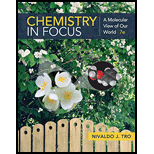
Concept explainers
Chemical Formulas
Determine the number of each type of atom in each chemical formula:
Want to see the full answer?
Check out a sample textbook solution
Chapter 4 Solutions
Chemistry In Focus
- Diamond is a natural form of pure carbon. What number of atoms of carbon are in a 1.00-carat diamond (1.00 carat = 0.200 g)?arrow_forwardA) Suppose one molecule of Chlorophyll X contains 5 oxygen atoms. Chlorophyll X is 8.95% oxygen by weight. Using only this information and the atomic mass of oxygen, determine the molecular mass of Chlorophyll X. B) The Chlorophyll X molecule contains one magnesium (II) ion. What mass of magnesium is found in 7.29 g of Chlorophyll X?arrow_forward1.25 moles of PbO2 have a mass ofarrow_forward
- 1. A sample of 2 tsp of sugar (C12H22O11) weighs 9.00 g. a. Record each step needed to calculate the moles and atoms of all elements present in the sample. b. Then, calculate the moles and atoms of each element in the sample of sugar on a sheet of paper. Show all work to answer this question. Take a photo of your work and upload the image into Photo 2.arrow_forwardCalculate the moles of CuCu in 8.2×1021 atoms of CuCu. Express your answer using two significant figures.arrow_forwardA 7.83-g sample of HCN contains 0.290 g of H and 4.06 g of N. Find the mass of carbon in a sample of HCN with a mass of 3.37 g.arrow_forward
- 1.50 g of CaCl2 is sissolved in water and combined with an excess of NaCO3 CaCl2 + Na2CO3 ---> CaCO3 (s) +2NaCl mistakenly you used LiCO3 instead of NaCO3, explain the effects on your experiment?arrow_forwardPlease show your complete solution in a paper. Thank you! Question: A solid cube of aluminum (density 2.70 g/cm3) has a volume of 0.200 cm3. It is known that 27.0 g of aluminum contains 6.02x10^23 atoms. How many aluminum atoms are contained in the cube?arrow_forwardWhich of the following contains the highest number of atoms? A) 1 mole of helium B) 1 mole of carbon C) 1 mole of uranium D) All contain an equal number of atoms E) Not enough infoarrow_forward
- Some students burned magnesium in excess oxygen, as described by the equation 2 Mg(s) + O2(g) --> 2 MgO(s) They recorded their data in the table below. Mass of crucible 33.84g Mass of crucible + Mg 35.51 Mass of Mg ? Mass of crucible + MgO 39.45 Mass of MgO ? Based on this data, what was the mass of Mg that the students began with? what was the mass of MgO that the students produced?arrow_forwardAcetaminophen, whose structure is drawn below, is the active ingredient in some nonprescription pain killers. The recommended dose for an adult is two 500-mg caplets. How many molecules make up one dose of this drug?arrow_forwardCalcium oxide (CaO), also known as quicklime, can be produced by heating calcium carbonate (CaCO3). It was found that 36.73 g CaO contains 26.25 g Ca. (a) The ratio of masses of calcium to oxygen in calcium oxidearrow_forward
- Chemistry: Matter and ChangeChemistryISBN:9780078746376Author:Dinah Zike, Laurel Dingrando, Nicholas Hainen, Cheryl WistromPublisher:Glencoe/McGraw-Hill School Pub Co
 ChemistryChemistryISBN:9781305957404Author:Steven S. Zumdahl, Susan A. Zumdahl, Donald J. DeCostePublisher:Cengage Learning
ChemistryChemistryISBN:9781305957404Author:Steven S. Zumdahl, Susan A. Zumdahl, Donald J. DeCostePublisher:Cengage Learning
 Chemistry: An Atoms First ApproachChemistryISBN:9781305079243Author:Steven S. Zumdahl, Susan A. ZumdahlPublisher:Cengage Learning
Chemistry: An Atoms First ApproachChemistryISBN:9781305079243Author:Steven S. Zumdahl, Susan A. ZumdahlPublisher:Cengage Learning Chemistry: The Molecular ScienceChemistryISBN:9781285199047Author:John W. Moore, Conrad L. StanitskiPublisher:Cengage Learning
Chemistry: The Molecular ScienceChemistryISBN:9781285199047Author:John W. Moore, Conrad L. StanitskiPublisher:Cengage Learning Chemistry & Chemical ReactivityChemistryISBN:9781133949640Author:John C. Kotz, Paul M. Treichel, John Townsend, David TreichelPublisher:Cengage Learning
Chemistry & Chemical ReactivityChemistryISBN:9781133949640Author:John C. Kotz, Paul M. Treichel, John Townsend, David TreichelPublisher:Cengage Learning





